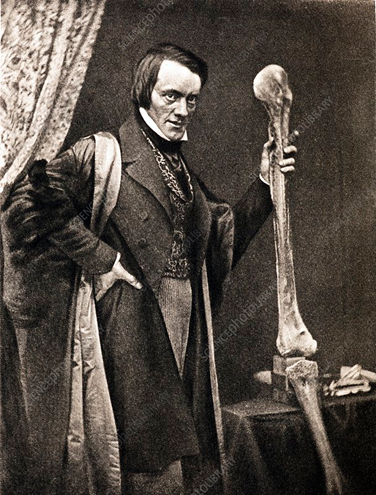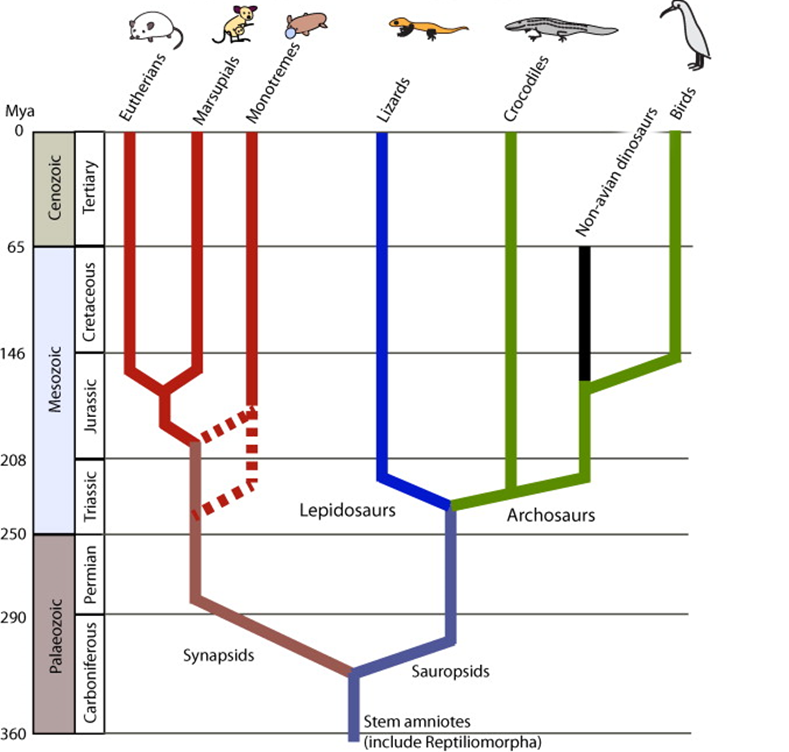(Abbreviation: mya = million years ago)
The exact date of discovery of the 1st dinosaur fossil is unknown; it is possible that fossils were discovered in the ancient world. Ancient Chinese writings dating 2000 years ago have mentioned “dragon” bones. They could have been referring to a dinosaur. In 1676, Reverent Robert Plot, an English museum curator found a large femur, which he believed belonged to giant humans. The specimen disappeared but its drawing remained. William Buckland, a British fossil hunter, discovered some fossils in 1819. He thought the fossils belonged to an ancient, larger version of a modern reptile. In 1841-42, Richard Owen compared the fossils and arrived at two conclusions: the pictures were similar and they were unlike that of any modern animals because they had 5 vertebrae in their tail bone whereas most known reptiles had only 2. He termed them “dinosaur” (derived from Greek words- deinos = “terrible”; sauros = “lizard”) [1].

Richard Owen with a leg fossil. Image source: https://www.sciencephoto.com/media/150901/view/1846-richard-owen-and-moa-leg-fossil
At the end of the 19th century, Othniel Marsh and Edward Cope formed research teams and competed with each other. This rivalry, called “Bone Wars”, led to the discovery of almost 136 new species of dinosaurs. Eventually, many scientists got inspired and started excavations of their own [2].

Othniel Marsh with his team. Image source: http://paleosleuths.org/oc_marsh.html

Edward Cope with the fossils he discovered. Image source: https://www.newyorker.com/books/page-turner/the-westworld-echoes-of-michael-crichtons-posthumous-dragon-teeth
It was found that dinosaurs held their limbs under the body in a columnar position. The fossils found in sedimentary rock date back to the Late Triassic (around 237 mya to 201.3 mya) and Cretaceous (around 66 mya) periods. Scientists know that dinosaurs were the dominant terrestrial lifeforms of the time because of the abundance of the fossils discovered. Although, the fossils found so far are only a fraction of the actual population, they have sufficed to tell us a lot about these majestic creatures.

Linnean classification of vertebrates. Image source: https://www.pmfias.com/classification-vertebrata-phylum-chordata/
The Linnaean classification system of vertebrates: fishes, amphibians, reptiles, birds, and mammals. It is not accurate because it is based on similarities in obvious physical traits. So, it’s very difficult to classify extinct living organisms based on fossils. Furthermore, fossils tend to be eroded over time. Using modern phylogenetic techniques that include genomic and 16S/18S RNA sequencing, it is possible to almost clearly classify living organisms today. This method was proposed by Carl Woese in 1990. And that’s how it is now known that birds (aves) are more related to dinosaurs than mammals.
When aquatic organisms came to the land, they developed different mechanisms to adapt to the new environment. Tetrapods developed two features: one where their eggs were still laid in water which led to the eventual evolution of amphibians. Second, they became amniotes; they are distinguished by the presence of a membrane (amnion) protecting the embryo and the lack of a larva stage. This led to the emergence of two groups, the synapsids (includes extinct and modern mammals) and sauropsids (includes all reptiles and birds). Sauropsids diversified immensely compared to the synapsids [3]. This is why the Mesozoic Era (250 mya to 66 mya), which included Triassic (252 mya- 201 mya), Jurassic (201.3 mya – 145 mya), and Cretaceous (145.0 mya- 66 mya), is referred to as the ’Age of Reptiles’.

Evolution of amniotes from tetrapods. Image source: https://www.researchgate.net/figure/Phylogenic-tree-of-amniotes-The-first-amniotes-appeared-approximately-350-million-years_fig3_260997108
The success of the dinosaurs is attributed to their anatomy. Unlike popular opinion, most dinosaurs were average-sized. Dinosaurs, like all reptiles, are cold-blooded creatures i.e poikilotherms (they cannot adjust their body temperatures according to their surroundings, so the only heat source to absorb the heat is from the sun [4]. This is in contrast to birds and mammals where they can regulate and adjust the body temperature according to the environment; they are thus, called homeotherms. During the Mesozoic Era, the Earth was warm with an average temperature of 16.5°C, 3 °C above the current global temperature [5]. The high temperature is predicted to be because of increased volcanic eruptions, which brought more CO2 into the atmosphere. This warm temperature was apt for the growth and development of dinosaurs.
Not all the dinosaurs we know today lived together.

A baby and an adult Thecodontosaurus antiquus. Image sources: http://museums.bristol.gov.uk/narratives.php?irn=11636
One of the best examples of a dinosaur of the Triassic period is Thecodontosaurus (derived from Greek; theco= “sheath”). Many species were found under this genus, the best-known being Thecodontosaurus antiquus. This herbivore was around 3.9 feet long from head to tail, 30 cm tall, and weighed around 11 kgs. Its jaw consisted of many small-to-medium-sized leaf-shaped teeth, thus the name [6].

Fossilized Stegosaurus. Image sources: https://www.zmescience.com/other/fossil-friday/fossilfriday-a-magnificently-fossilized-stegosaurus/
The Stegosaurus, characterized by the geometrical scales on its spine, lived during the Jurassic period. It was also a herbivore with a size of about 10 feet and weighed around 500 kg [7].

A fossilized Tyrannosaurus Rex. Image source: https://www.amnh.org/exhibitions/permanent/saurischian-dinosaurs/tyrannosaurus-rex
The most famous dinosaur, the Tyrannosaurus Rex (Greek; = ‘king of tyrant lizards’) lived at the very end of the Cretaceous period. The T-rex is actually closer to modern humans than it is to the Stegosaurus. Yes! Although the time scale of dinosaurs is calculable, it is incomprehensible. It weighed around a whopping 6000 kg, 40 feet long and 12 feet high. They lived geographically in the western regions of North America. A fierce carnivore with 60 teeth, each around 8 inches long it is considered one of the most ferocious predators to walk the planet; the teeth enabled it to grip flesh effectively so as to throw the prey into the air before swallowing it whole [8].

A fossilized Velociraptor mongoliensis. Image source: https://www.scientificamerican.com/article/new-fossil-reveals-velociraptor-sported-feathers/
Another interesting dinosaur that lived during the end of the Cretaceous period (not a T-rex contemporary) is the feathered dinosaur, Velociraptor mongoliensis. The fossil had quill knobs bumps along its forearm that anchor feather quills to the bone and that was very common to modern birds. But its arms were short and its skeletal structure couldn’t have supported it for flying. However, modern genomic evidence shows that birds and Velociraptors share a common ancestor [9].

An Archaeopteryx fossil. Image source: https://www.bbc.com/news/science-environment-22695914
Another famous bird-like dinosaur, the Archaeopteryx, was actually alive during the Jurassic period. The Archaeopteryx and Velociraptor have common ancestors but they existed in completely different periods i.e Jurassic and Cretaceous respectively [10]. The Archaeopteryx had many similarities with the modern birds. Archaeopteryx has well-developed wings, the structure and arrangement of its feather were similar, which shows that they could fly. However, they could fly only for short distances because the skeletal structures were incompletely developed. Studying the pigments indicates the feather were black.
Around 66 mya, an asteroid hit present-day Mexico. The common impression is that one asteroid killed all the dinosaurs. Actually, this is far from the truth. The dinosaur population was already in decline because of competition, depleting resources, climate change, plate tectonics, etc. it has been hypothesized that when the asteroid hit, it caused a major impact on Earth. Apart from the resulting earthquakes, the shockwaves literally lifted all the dust on terrestrial earth, effectively blocking the sun. this caused less sunlight to fall on Earth’s surface, thus cooling the temperature of Earth. Decreasing the sunlight also meant that plants couldn’t photosynthesize, which depleted the resources further, especially for the herbivorous dinosaurs. As discussed before, reptiles need warm temperatures to thrive as they are cold-blooded and don’t maintain a constant body temperature. This decreased temperature and lack of resources eventually declined the reptile’s population after the asteroid hit. It seems the asteroid just hit fast-forward on their extinction.
Only the avian dinosaurs (bird-like dinosaurs) survived along with mammals. Mammals were small then, so they needed lesser resources for survival. Their tiny stature helped him to burrow into the ground to protect themselves. Mammals and birds are warm-blooded, so they could adjust their body temperature even if the cold became unbearable due to lack of sunlight. Thus, mammals and birds eventually evolved to possess the present-day characters.
The hit of the asteroid and the consequent disappearance of dinosaurs is marked as the end of the Mesozoic Era and the beginning of the Cenozoic Era, extending to the present day. It was during this time, the current geographical features started to form. This led to the evolution of the modern characteristic birds, modern mammals, and flowering plants.
Examples like the Velociraptor and Archaeopteryx show how avian characteristics like feathers and light hollow bones have evolved. The heat provided by the feathers isn’t a product of eventual evolution. It has been seen in different dinosaurs periodically.
Direct ancestry and common ancestor are often interchanged but it’s not right scientifically. Common ancestor says that a single type of organism was diversified into different organisms. Direct ancestry says that one organism eventually evolved into an organism that is recognizable in the present day. So, it isn’t that dinosaurs are the direct ancestors of birds. Nevertheless, they do have a common ancestor.
In other words, birds are the surviving members of the dinosaur lineage.
References
[1] Padian, K (1999) Dinosaur [Online]. Available at: https://www.britannica.com/animal/dinosaur (Accessed: 23 January 2022)
[2] The Academy of Natural Sciences of Drexel University, Bone wars: the cope-marsh rivalry [Online]. Available at: https://ansp.org/exhibits/online-exhibits/stories/bone-wars-the-cope-marsh-rivalry/ (Accessed: 23 January 2022)
[3] Philip J. Currie Dinosaur Museum, A brief history of mammals part 1: the early synapsids [Online]. Available at: https://dinomuseum.ca/2020/02/11/a-brief-history-of-mammals-part-1-the-early-synapsids/ (Accessed: 23 January 2022)
[4] American Museum of Natural History, Dinosaur facts [Online]. Available at: https://www.amnh.org/dinosaurs/dinosaur-facts (Accessed: 23 January 2022)
[5] Price G.D (2009) Mesozoic climates [Online]. Available at: https://link.springer.com/referenceworkentry/10.1007%2F978-1-4020-4411-3_138 (Accessed: 23 January 2022)
[6] Natural History Museum, Thecodontosaurus [Online]. Available at: https://www.nhm.ac.uk/discover/dino-directory/thecodontosaurus.html (Accessed: 23 January 2022)
[7] Natural History Museum, Stegosaurus [Online]. Available at: https://www.nhm.ac.uk/discover/dino-directory/stegosaurus.html (Accessed: 23 January 2022)
[8] American Museum of Natural History, 7 questions about tyrannosaurus rex [Online]. Available at: https://www.amnh.org/dinosaurs/tyrannosaurus-rex (Accessed: 23 January 2022)
[9] The Editors of Encyclopaedia Britannica (1999), Velociraptor [Online]. Available at: https://www.britannica.com/animal/Velociraptor (Accessed: 23 January 2022)
[10] University of California Berkeley Museum of Paleontology, Archaeopteryx: an early bird [Online]. Available at: https://ucmp.berkeley.edu/diapsids/birds/archaeopteryx.html (Accessed: 23 January 2022)

Comentarios